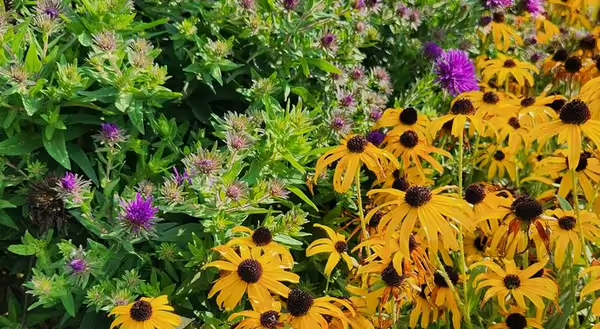
By Ellen Denler, Extension Master Gardener serving Fulton, Mason, Peoria and Tazewell counties
Thank you to Ellen Denler for sharing her thoughts on "When is A Garden Not a Garden." Ellen is an Extension Master Gardener and Conservation@Home member. She has a passion for creating outdoor spaces that provide ecological benefits.
The dictionary definition of garden is “a space where plants are displayed, cultivated, and enjoyed.” In recent years that definition has changed a great deal. With the increased use of native plants, gardens have become more—well---wild. The addition of these plants to our yards has sometimes brought rude comments from casual observers.
Daylilies, hostas, and daisies are recognized by these individuals, but Joe Pye, rattlesnake master, and cup plants are not. In most cases “to be known is to be loved.” If someone doesn’t recognize a plant it is too often called-----gasp-----a “weed.”
In the old days proper plant display was even more important than the collection of plants. Unfortunately, this is still the case for a lot of the traditional gardeners who adopt that formal, strict style. They use three plants here, three plants there, and apply more than enough mulch to smother anything that wasn’t purposely put in their design.
As this style became a little “looser” a more natural approach was encouraged. Drift planting popularized by Dutch plantsman Piet Oudolf caught on. The New Perennial Movement was born. This style used native and non-native plants which were planted in “drifts” or mass plantings.
Next came the meadow phase of design which encouraged a pollinator friendly garden. It was lower maintenance and a more accurate representation of nature. It reflected the prairies of the Plains. But critics once again asked,” When is a garden not a garden?”
Sadly, many of them answered, “When it’s a MESS!”
We grow natives for good reasons and should encourage those traditionalists to do the same.
But do we? We know how natives benefit the environment but even more importantly do our yards motivate others to plant them too? Or do we adopt a superior attitude which turns traditionalists off?
Look at nature—there is order and design—not forgetfulness. Nature is lovely and our gardens must be too. Remember that a garden is not a garden without human intervention. We are important to the process.
Landscape architect Preston Montague who has designed native plans for Wild Ones says, “Design happens after planting…..maintenance is that design process.” This means that your garden plans should evolve. Ignore those traditional design practices and “edit” the unruliness. Supervise! Evaluate!
And make those critics answer when asked, “When is a garden NOT a garden?”
“When you don’t use natives.”